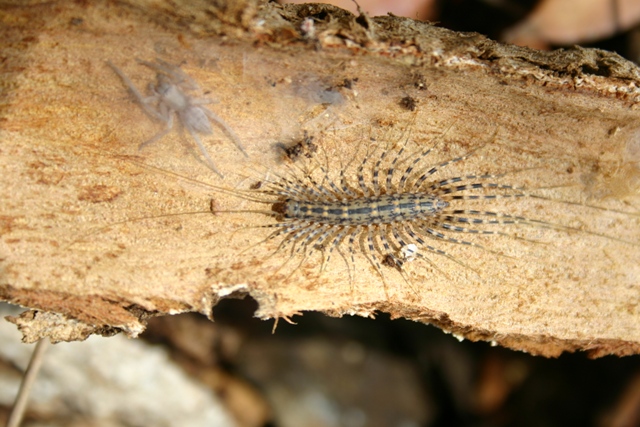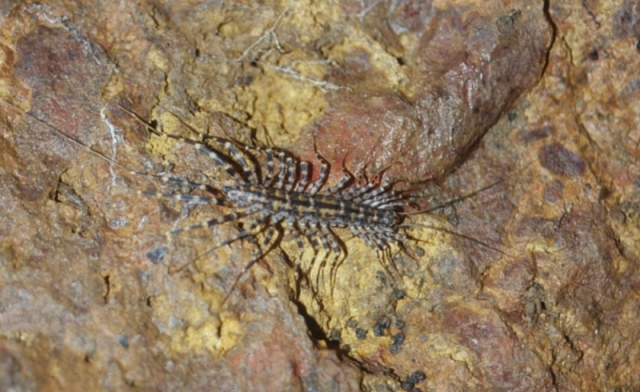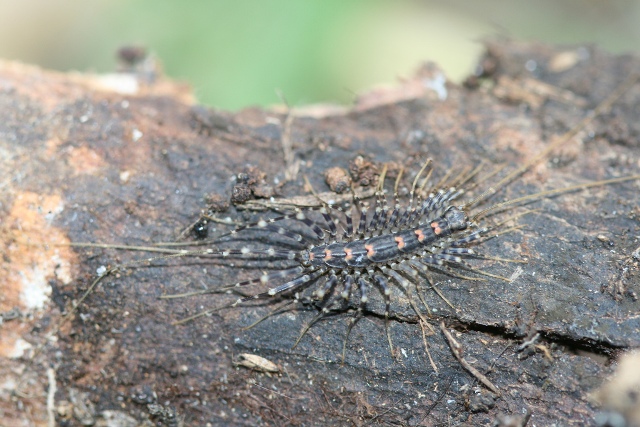Phylum Arthropoda
Subphylum Myriapoda
Class Chilopoda
Order Scutigeromorpha
Common names: house centipedes, scutigeromorphs
Overview
Scutigeromorpha are relatively short-bodied centipedes that have 15 pairs of long legs that increase in length posteriorly and consist of multi-segmented tarsi. The head is hemispherical or dome shaped with whip-like lateral antennae. They are the only centipede group to retain their compound eyes with which a crystalline layer analogous to that seen in chelicerates and insects can be observed. A pair of sensory organs termed �T�m�sv�ry organs' are located below the eyes on each side. The trunk is not dorsoventrally flattened, and while adults have 15 ventral plates, there are only seven large tergites because of tergal fusion. Scutigeromorpha are the sole extant representative of the subclass Notostigmomorpha, defined by having single spiracle openings on the back of their ventral plates. The more derived groups bear a plurality of spiracular openings on their sides, and are termed the Pleurostigmomorpha. Further differences between scutigeromorphs and the other orders include spiracles located on the tergites instead of on the pleurites, and neither the clypeus nor the head pleurites folded underneath. Scutigeromorphs are extremely fast, agile, and delicate centipedes that are difficult to catch and collect intact.
Distribution and diversity
The Scutigeromorpha is comprised of three families, 16 genera, and around 80 described species out of an estimated global fauna of 100-150 species. There are 19 scutigeromorphs described in Australia.
Life cycle
House centipedes display more ritualised mating behaviour than that of other chilopods. Male and female tap and caress heads with their antennae, the male moves towards and under the female�s raised body. The male also performs bobbing movements periodically, and eventually deposits a spermatophore on the ground, which is then taken up by the female and deposited into her genital opening. The eggs are laid singly and are coated in soil before being placed into a crevice in moist soil. Scutigeromorphs demonstrate anamorphic development, hatching from the egg with only four segments and leg pairs and add legs and segments at subsequent molts. The full complement of legs and segments is achieved several moults prior to maturity. There is little or no sexual dimorphism except for the gonopods and anal legs.
Feeding
House centipedes are voracious predators and usually hunt down insects and spiders. Prey is ensnared with the posterior legs and is quickly bitten and immobilised with the poison claws. The prey is torn into small pieces and only soft and small particles are ingested.
Ecology
House centipedes are active predators, however their impact on terrestrial invertebrate communities in unknown. Although centipedes are cosmopolitan, and can be found in many varied habitats, they are found mainly in temperate and subtropical regions, living alone among leaf litter, under bark, stones, in the soil or in any other moist microhabitat. House centipedes occasionally enter human dwellings, hence the name, although they pose no significant threat to the people.

Scutigeromorpha from Western Australia
Image credit: Photographer: Mark Harvey
� Western Australian Musuem

Scutigeromorpha from Western Australia
Image credit: Photographer: Erich S. Volschenk
� Western Australian Musuem










